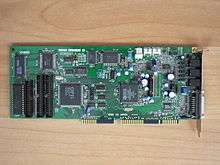Yamaha YMF278
The Yamaha YMF278B, also known as the OPL4 (OPL is an acronym for FM Operator Type-L), is a sound chip that incorporates both FM synthesis and sample-based synthesis (often incorrectly called "wavetable synthesis") by Yamaha.
Sample-based synthesis component
The sample synthesis part is based on pulse-code modulation (PCM). It features:
- Up to 24 simultaneous sounds (voices)
- Output sampling frequency of 44.1 kHz (it can also accept 22.05-kHz samples – they are up-sampled to 44.1 kHz before output)
- Waveform data lengths of 8, 12, or 16 bits
- Stereo output (with a 4-bit/16-level pan for each voice)
The PCM synthesizer part accepts:
Frequency modulation synthesis component
The FM part is essentially a YMF262 (OPL3) block; thus, it is also backwards-compatible with the YM3526 (OPL) and the YM3812 (OPL2). Like the OPL3, it can operate in one of four ways:
- 18 two-operator FM channels
- 6 four-operator FM channels + 6 two-operator FM channels
- 15 two-operator FM channels + 5 FM drums
- 6 four-operator FM channels + 3 two-operator FM channels + 5 FM drums
Four-operator FM allows more complex sounds but reduces polyphony.
Eight waveforms are available for the FM synthesis:
- simple sine
- half sine
- absolute sine
- quarter sine
- alternating sine
- "camel" sine
- square
- logarithmic sawtooth
Unlike the OPL3, which has four channels for sound output, the OPL4 features six channels.

Applications
The YMF278B was used in the Moonsound MSX sound card and in Yamaha's SoundEdge sound card for IBM PC and compatibles.
A stripped-down version of the YMF278 (removing the FM synthesis section) was built for Sega as the MultiPCM. Yamaha internally identifies the chip as the YMFA1005 whereas Sega uses the part number 315-5560. This version of the chip was used in conjunction with the YM3438 which provided sound timer controls.
Connectivity
For ROM wave data access, the Yamaha YRW801 2MB ROM chip can be connected to the OPL4. It holds approximately 330 samples, mostly 22.05-kHz 12-bit samples with some drums at 44.1 kHz. It is compatible with the General MIDI standard (128 melody sounds, 47 percussion sounds).
For sound effects, the OPL4 can be connected to the Yamaha YSS225 effects processor (EP), which adds various sound effects.
Like all its predecessors, the OPL4 outputs audio in digital-I/O form, thus requiring an external DAC chip. For this purpose, the Yamaha YAC513 DAC was designed.